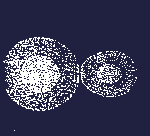
1
In a series of papers the author, with W. Benz and others [Paper I: Benz et al. (1986), Paper Il: Benz et al. (1987), Paper III: Benz et al. (1989), Paper IV: Cameron and Benz (1991)], investigated this scenario through a number of simulations of the hypothetical Giant Impact. The tool used for the simulations was smooth particle hydrodynamics (SPH). In this method the domain of the computation is not divided into spatial cells, as in ordinary hydrodynamics, but rather the matter in the domain of computation is divided into smooth overlapping spheres. The density of a sphere has a radial distribution that is bell- shaped, with highest density at the center and a sharp outer edge. The particles carry individual internal energies, but such properties as density and presssure are collectively deterrnined by the overlap between the density distributions of the particles; these are meaningful only when typically a few tens of particles contribute to the overlap.
The previous series of simulations were carried out with both the Protoearth and the Impactor set to a ternperature of 4000 K, presumed to have been developed by a prior history of collisions in the accumulations of these bodies. With the newer code, extensive evaporation of rock vapor would occur at this temperature, so the initial temperature was lowered to 2000 K to prevent this. The purpose of this assumption was to prevent rock evaporation from the planetary surfaces prior to collisions. The initial internal temperatures are underestimated by this assumption, but the present code does not support rigidity in solid materials, so the hydrodynamics are essentially unaffected by the lower temperature. The focus of this investigation is on the external matter in any case, so from that point of view it does not matter that the shock-induced internal temperatures may be slightly underestimated.
One run each was made with Protoearth-to-Impactor mass ratios of 5:
5, 6: 4, and 7: 3, each with somewhat more than the angular momentum of
the Earth-Moon system today. The remainder of the simulations were done
for a ratio of 8:2 but with a variety of angular momenta in the collisions.
One of the runs consisted of a central impact with zero angular momentum.
On the 486 machines the current state of the computation was normally
displayed during the run as a color plot of the computational geometry.
The internal energy of the particles was indicated to be within one of
four energy ranges by the use of four different colors each for rock (dunite)
and iron. The boundaries between these colors were empirically determined
to provide a useful spread in the diagnostics over the range of conditions
typically encountered in a Giant Impact. The higher values of the boundaries
for iron reflect the fact that iron cores are typically heated to much
higher temperatures than dunite mantle material in the course of the collisions.

1 |
Figure 1 shows a high-angular-momentum symmetric collision between equal masses (half an Earth mass each). The two bodies collide, form a very elongated configuration, fall back together, and then a hole opens up in the middle of the configuration. The hole closes as the main parts of the two bodies collide again. The iron cores merge into a central core surrounded by a very flattened oblate spheroid of rock. It is especially noticeable that in regions where very hot rock is exposed on the surface, rock vapor particles evaporate to form a small cloud of particles near such hot regions, and then these particles gradually spread around the entire planetary body. In the final panel, the postcollision body has become circular when viewed from the pole direction, as here, but is actually very rotationally flattened. The evaporated particles in the cloud surrounding the body are clustered most strongly toward the surface, as is characteristic of an atmosphere, and the density of these particles falls off away from the surface. Also visible at larger distances from the surface are many cooler (i.e., condensed) particles shed at an earlier stage of the collision.
There is a characteristic outcome to all of the other asymmetric simulations. In the collision, the Impactor (i.e., the lower-mass body) becomes distorted and elongated; the bulk of it falls out into the Protoearth, including essentially all the central iron, which plunges right through the rock mantle of the Protoearth. The rock part of the Impactor farthest away from the point of impact has a general tendency to go into orbit about the Protoearth as individual particles (but sometimes as clumps of particles); however, the fallout of the iron core of the Impactor initially accumulates in a relatively small volume on one side of the Protoearth core, forming a rotating iron bar-like configuration inside the Protoearth. This can exert a powerful torque on clumps of particles outside the Protoearth, including in particular that part of the Impactor that would go into orbit but that is still largely contained in a relatively small volume. As the Impactor iron settles into the Protoearth core, the external rock material from the Impactor tends to be spread out into a trailing spiral wave and to move to larger radii. The higher-angular-momentum cases often involve two collisions before the iron fallout goes to completion.
It was very striking to see, everywhere that a collision had heated the surface material of a planetary body, that a cloud of vapor particles arose above the surface and spread to surround the planetary body. For the 8:2 and 7 :3 mass ratio cases it was possible to see that most of the particles (and a majority of the mass) in the cloud were originally Impactor particles. Evidently when the planetary surface was heated by Impactor rock infall, the Impactor particles would tend to be on top of the Protoearth ones, and thus they would be first to evaporate. The cloud was always densest next to the planetary surface and thinned out away from the surface, as would be expected for an atmosphere. This phenomenon was a major departure from that observed in the previous runs because the particle evaporation and formation of an atmosphere could not be properly simulated with fixed smoothing lengths and relatively few external particles.
The final states of the Protoearth following all of the collisions were remarkably similar. For this reason it is sufficient to show the results of four of the cases, and the central collision. The figure 1 represents a high-angular-momentum collision between two planets of half an Earth mass each, in figures 2 and 3 relatively low and high-angular-momentum collisions between objects of 0.2 and 0.8 Earth mass, and in figure 4, the central collision masses also of 0.2 and 0.8 Earth mass.

2 |
Figure 2 shows the results of a low-angular-momentum collision between objects of 0.2 and 0.8 Earth mass. The Impactor is destroyed through elongation. The side of the Impactor Iying toward the center of the Protoearth is slowed in its motion by running into Protoearth material, whereas the other side encounters little such resistance and is slowed down much less. The iron core of the Impactor, being much denser, penetrates through most of the rock material and thus appears almost entirely on one side of the drawn- out debris. This iron core quickly falls back onto the Protoearth and penetrates through the rock mantle to pile up on one side of the Protoearth core. The rock that is left behind is distributed along an arc extending away from the Protoearth, but Iying on orbits that would bring it back to intersect the Protoearth surface if it were not for gravitational torques exened by the nonspherical mass distribution of the Protoearth and the mass in its vicinity. It may be seen that the Impactor iron has not had time to fully settle into the larger Protoearth core, and thus the mass distribution of the iron forms a rotating quadrupole, capable of exerting such gravitational torques. There is enough mass in the trailing rock arc to become gravitationally unstable and partially contract into a distinct clump of material, until the clump impacts the surface. The evaporation of hot material from the Protoearth surface can be seen to be continuing; it has formed an extended atmosphere.

3 |
Figure 3 shows the results of a high angular-momentum collision between objects of 0.2 and 0.8 Earth mass. The Impactor is stretched through a greater degree of elongation than in figure 2. The elongated material begins to gather itself together beyond the Roche lobe of the Protoearth. The iron core of the Impactor drifts toward the leading edge as before, but it does not immediately fall into the Protoearth. The bulk of the material in the Impactor pulls itself together into a roughly spherical object, with the bulk of the iron core now again at the center (some of this Impactor core did fall into the Protoearth). The two planetary bodies are connected only by a thin line of material, and shortly afterward almost all of the remaining particles fall into one or the other planetary body. The reconstituted Impactor withdraws to a maximum distance of a few Protoearth diameters and then falls back to impact the Protoearth a second time. This time the Impactor is fully destroyed, and as in figure 2, the rock is drawn out into an arc while the iron falls into the Protoearth. Once again the Protoearth forms a rotating quadrupole. The rock arc becomes very elongated and shows signs of instability. Two clumps form from this arc; these have a fairly strong interaction. The closer clump gives up some of its angular momentum to the farther one and impacts the surface. The final panel shows the system some time later when the mass quadrupole has substantially subsided and the remaining clump has gone into a stable orbit that lies everywhere beyond the Roche lobe of the Protoearth. As in figure 2, an extended atmosphere formed.
The sequence shown in Fig. 3 is typical of the higher angular-momentum cases that were run; in these cases two clumps resulted that behaved as shown in this figure. One of the clumps fell into the Protoearth and the other went into orbit. The surviving clump always had a mass much less than that of the Moon for the angular momentum range used in these cases.

4 |
The central impact case between objects of 0.2 and
0.8 Earth mass was run in part to study the formation of the
impact-generated rock vapor atmosphere for a case uninfluenced by angular
momentum. The case provided some rather spectacular examples of extreme
deformation as a variety of modes of oscillation were induced in the Protoearth
and as the resulting mechanical energy was gradually dissipated into heat.
The sequence is shown in Fig. 4. The impact occurs along the x axis (horizontal
in the figure), and the large translational energy along this axis therefore
excites modes with a predominance of x-axis deformation. When the Protoearth
rebounds from such a deformation, the result is a symmetric deformation
in the yz plane. Both the merged iron core and the rock mantle participate
in the x-axis deformations, and the iron core itself has a small oscillation
relative to the center of mass of the rock mantle. The damping of these
motions is relatively rapid; the sequence of panels in the figure shows
all of the major deformations that took place until the amplitude had greatly
diminished. It may be seen that the iron core is quickly heated to high
internal energy, and the mantle is somewhat more slowly heated. At the
end of the sequence the rock is roughly half-heated to the highest internal
energy interval and half to the next lower internal energy interval. The
rock hemisphere farthest from the point of collisional impact (on the leh)
has clearly had more energy dissipated than the nearest hemisphere (on
the right). Where the surface is hottest, the rate of particle evaporation
is highest. By the end of the sequence an extended atmosphere had formed.
What is not shown in this figure is that a significant number of the vaporized
rock particles acquired a portion of the initial translational energy of
the Impactor and formed a wind of rock vapor extending downstream in the
direction of the impact. In most of the cases some of the particles escaped
to infinity either as a wind (as in this case) or during the collision,
but the amount of mass lost in this way was quite small.
The above description would apply to just about any Giant Impact involving an Impactor with at least 10% of an Earth mass. A candidate Moon-forming Giant Impact must also possess at least the present value of the Earth-Moon angular momentum, which places constraints on the Impactor. Previous papers in this series have shown that the Impactor needs to have at least 14% of an Earth mass to swallow up the Impactor iron core and avoid getting too much iron in the Moon. But apart from this constraint it appears from the present simulations that any division of mass between the Protoearth and the Impactor can produce a promising set of conditions.
But how would the present set of similar scenarios evolve at subsequent.times? Production and transport of radiation are not permitted by the code to occur in these models. The rationale for omitting them is that the time involved in the simulations is at most a day or two. In reality the scenarios would lead to cooling of the rock vapor atmosphere and precipitation of refractory materials at larger distances in the rock vapor atmosphere as it extends out into the equatorial plane. But the amount of mass in the atmosphere beyond the Roche limit (at 2.89 Earth radii) is far too little to form the Moon.
A scenario that might work under these conditions would be one in which most of the material in the Moon comes from that part of the Impactor that has been torqued into high Earth orbit, which requires a high-angular-momentum collision. Several geochemists have told me of their dismay at the thought of having to accept such a scenario; however, as noted above, the satellites produced in the higher-angular-momentum collisions in the 8:2 mass ratio cases run here have too little mass to form a satisfactory Moon, even allowing for subsequent accretion. This suggests the desirability of simulating somewhat more symmetric collisions than 8:2 and higherangular-momentum collisions, a combination of parameters that has not been explored. A major question for scenarios of this type is whether such a fragment of the impactor could lose enough volatile materials to resemble the composition of the Moon.
The problem of forming the Moon from a disk extending beyond the Roche limit has been analyzed in considerable detail by Canup and Esposito (1996). The required conditions turn out to be very constraining. The formation of a single lunar body requires that the many smaller bodies that might form out of the disk should decrease outward in mass, a condition that is contrary to their natural tendency unless the surface density of mass in the disk very steeply decreases outward. They find for this class of models that the total angular momentum in the collision must be about twice that in the current Earth-Moon system. This is not very different from many of the cases considered in the current set of runs. I find the results of this analysis to be very discouraging for those scenarios that involve relatively low-angular-momentum collisions, similar to case 6.
The angular momentum chosen for the runs in the current series was much higher than the value for the current Earth-Moon system. A motivation for this choice was to attempt to place material at larger distances from the Earth to promote lunar formation. But this raises the question of how the excess angular momentum is to be lost. One can postulate that a lot of mass was thrown out of the system at an early stage in the postcollisional evolution, but it is far from obvious how this might take place on a sufficient scale.
We know that angular momentum has been lost from the system as a result of solar tides on the Earth. The ratio of solar to lunar torque due to the ocean tide is 0.20, but if nonlinear friction in the oceans is taken into account, this increases to 0.29 (Munk and MacDonald 1975). Since lunar tides would have been relatively stronger in the early history of the Earth, it is most unlikely that more than a small part of the discrepancy can have been due to solar tides.
The Giant Impact, however, could have taken place when the Earth was only some 50 to 90% accumulated. If the Protoearth was only 50% accumulated, then the mass ratio of the Impactor to the Protoearth was still probably only around a third of the mass of the Protoearth, and the Giant Impact would be a scaled-down version of that illustrated in this paper, and the angular momentum would be similarly reduced. It remains to be seen how other aspects of the collision would scale. In this scenario one would look for the higher-angularmomentum cases in which a lunar-mass body is left in orbit but also leaving the system with roughly the present angular momentum.
If the Giant Impact took place when the Protoearth was 90% accumulated, then the last 10% of the mass to have been accumulated is likely to have included some very large bodies, perhaps including one of several percent of the Earth mass. For example, if the Impactor in the Giant Impact was a third of the mass of the Protoearth, then the second most massive object to be accumulated might have a mass about a third of that of the Impactor. This would be about 10% of an Earth mass. If this struck the Earth randomly after the Giant Impact, the angular momentum of the Earth-Moon system could have been very significantly modified.
The formation of the Moon as a postcollision consequence of a Giant
Impact remains a hypothesis. The previous papers in this series appear
to have characterized the internal effects of a Giant Impact on the Protoearth.
The present paper has characterized the external environment of the Protoearth
following a Giant Impact. The most promising direction for future simulations
appears to involve Impactor/Protoearth mass ratios around 0.3 to 0.5 but
a total mass at the time of the collision substantially less than a present
Earth mass, and one would search for conditions in which a lunar-mass body
is left in orbit after the collision.
(Paper 1) BENZ, W., W. L. SLATTERY, AND A. G. W. CAMERON 1987. The origin of the Moon and the single impact hypothesis 11. Icarus 71, 30-45. (Paper 11)
BENZ, W., A. G. W. CAMERON, AND H. J. MELOSH 1989. The origin of the Moon and the single impact hypothesis III. Icarus 81, 113-131. (Paper 111)
CAMERON, A. G. W. 1985. Formation of the prelunar accretion disk. Icarus 62, 319-327.
CAMERON, A. G. W., AND W. BENZ 1991. The origin of the Moon and the single impact hypothesis IV. Icarus 92, 204-216. (Paper IV)
CAMERON, A. G. W., AND W. R. WARD 1976. The origin of the Moon. Proc. Lunar Planet. Sci. Conf 7th, 120-122.
CANUP, R. M., AND L. W. ESPOSITO 1996. Accretion of the Moon from an impact-generated disk. Icarus 119, 427-446.
HARTMANN, W. K., AND D. R. DAVIS 1975. Satellite-sized planetesimals and lunar origin. Icarus 24, 504-515.
MUNK, W. H., AND G. J. F. MAcDoNALD 1975. The Roration of the Earth. Cambridge Univ. Press, Cambridge, UK.
STEVENSON, D. J. 1987. Origin of the Moon: The collision hypothesis. Annu. Reu. Earth Planet. Sci. 15, 271-315.
THOMPSON, A. C., AND D. J. STEVENSON 1983. Two-phase gravitational instabilities in thin disks with application to the origin of the Moon. Proc. Lunar Planet. Sci. Conf 14th, 787-788.
THOMPSON, A. C., AND D. J. STEVENSON 1988. Gravitational instability in two-phase disks and the origin of the Moon. Astrophys. J. 333, 452481.
WARD, W. R., AND A. G. W. CAMERON 1978. Disk evolution within the Roche limit. Proc. Lunar Planet. Sci. Conf. 9th, 1205-1207.
Subject: Re: lunar question Date: Mon, 17 Nov 1997 10:51:39 -400 From: "Al Cameron" ( acameron@cfa.harvard.edu ) Organization: Harvard College Observatory To: Antoni Parra ( aparra1@pie.xtec.es )
By looking at the first panels on each series, I was surprised by seeing so little deformation on the smallest body. I thought that tidal stress had to tear it apart before the impact. Or I'm wrong?
Not completely. Tidal deformation makes the smaller body somewhat pear-shaped just before contact (a slightly more pointed small end). There is not time for more than this.
Case 8 looked to me the most interesting one: panel 8e could be the first 'frame' of a slower tangential 'meeting', couldn't it? I wonder if the minor body would disintegrate the same way. (the same result with less angular momentum...?)
You can see from panel 8a that the smaller body was significantly deformed on collision. 8e is a similar case but this is just before collision, but the direction of motion is "west-north-west" rather than tangential, so the impact parameter is smaller than in 8a.
Saturns' rings probably originated when a satellite crossed Roche limit. But, couldn't they had been produced by impact instead?
It is expected that Saturn's rings have a lifetime much less than that of the solar system, so they must be renewed. Probably a combination of satellite erosion and Poynting-Robertson (which in this case will push the particles in toward Saturn rather than the Sun).
I'm only a teacher on Earth's sciences, so, forgive my 'silly' questions, please.
Questions are seldom silly.
Regards, Al Cameron
******************************************************* A. G. W. Cameron Donald H. Menzel Professor of Astrophysics Harvard College Observatory 60 Garden Street Cambridge, MA 02138 Email:acameron@cfa.harvard.edu Phone: 617/495-5374 Fax: 617/495-0372 *******************************************************